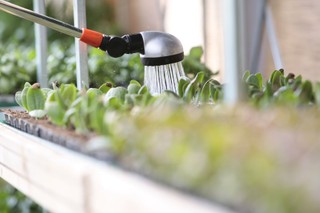Fertilizer for herbs: Benefits, types, and how to fertilize

Just like people need food, and cars need gasoline, plants need nutrients to “fuel” their growth. Herbs are no exception to this. However, their needs are slightly different than other vegetable or ornamental plants, especially when grown in containers. Understanding why fertilization is important and how to do it correctly encourages strong, healthy growth in your herb garden.
Importance of fertilizer
All plants have certain nutrients that are essential for plant growth. This includes nitrogen, phosphorus, potassium, calcium, sulfur, magnesium, sodium, boron, chlorine, manganese, iron, zinc, copper, molybdenum, and nickel.
Nutrients are found naturally in the soil. As plants absorb and use them you have to add them back into the soil using fertilizers. A lack of any specific nutrient will cause deficiency symptoms within your plan, affecting growth.
To simplify plant nutrition needs, many focus primarily on nitrogen, phosphorus, and potassium. But why are these three important?
- Nitrogen regulates vegetative growth and keeps leaves green.
- Phosphorus makes up the genetic building blocks within plant cells. It is also needed for root growth and flowering.
- Potassium works by activating enzymatic reactions.
Different types of fertilizer
Deciding on what type of fertilizer to use can be challenging. There are many different types of fertilizer available for purchase. A quick look online or locally is often overwhelming because of the numerous options to choose from.
When looking at fertilizers, it helps to understand the differences in the types. There are three main characteristics that differentiate fertilizers from one another: chemical makeup, nutrient availability, and product form.
They can be inorganic or organic, slow-release or quick-release, and granular or liquid. Which product you choose depends on your own preferences.
Inorganic versus organic
Inorganic fertilizers - often called conventional or chemical fertilizers - are made using mineral deposits or synthetic, manmade materials. The nutrient sources used as ingredients are quickly available to plants after application. This is a benefit since plant deficiencies can be quickly fixed, minimizing long term damage.
On the other hand, organic fertilizers are made from all-natural, organic sources. They are considered natural fertilizers and usually contain broken down remains of organisms or waste byproducts of such organisms. Due to their composition, some of the nutrients found in organic fertilizers are not readily available for plant uptake. After application, microorganisms and bacteria need to break the materials down. Then the nutrients are released and can be used by plants.
Compared to chemical fertilizers, organic fertilizers benefit soil microbes and improve the soil structure over time. The positive influence on the physical, biological, and chemical properties of the soil are increasing their popularity among gardeners.[1] [2] [3]

Slow release versus quick release
Nutrient availability differs immensely between slow-release and quick-release fertilizers.
Slow-release fertilizers are comprised of ingredients that will break down over time. This provides a gradual source of nutrition to plants.
Quick-release fertilizers have all of the nutrients available for plant uptake immediately. This helps to minimize long term impacts from deficiencies. It also increases the probability nutrients will leach out of the soil quickly.
Granular versus liquid
Lastly, the type of fertilizer can be split into either a granular or liquid product.
Granular fertilizers are also known as dry fertilizers. Dry nutrient sources are mixed together and then incorporated into granules for easy application. Their nutrients can either be quick-release, available immediately for plants, or slow-release to feed over a longer period of time.
Liquid fertilizers are manufactured in water-soluble concentrates. They are meant to be diluted in water. The fertilizer solution is applied when the plants are watered. Liquids are well-liked by indoor gardeners because they mix easily and thoroughly. One of their main drawbacks is they are not available as slow-release.
On the upside, plants can’t tell the difference in nutrients supplied by either form.
N-P-K Ratio
To help make it easier to understand nitrogen (N), phosphorus (P), and potassium (K) are used to label fertilizers. This allows consumers to easily compare different products regardless of their makeup or nutrient availability.
The numbers found on the fertilizer label are known as the N-P-K ratio (nitrogen-phosphorus-potassium). This tells the percentage, by weight, of the three main nutrients in the bag. For example, a 10 pound bag of 5-10-10 fertilizer, contains 0.5 pounds of nitrogen, 1 pound of phosphorus, and 1 pound of potassium.

The enthusiast's guide to herbs
We’re proud to present our new e-book, The Enthusiast’s Guide to Herbs! Learn everything you need to know about growing and caring for herbs indoors, including in-depth info cards for the 35 most commonly grown herbs.
Click the link below to find out more!
How to fertilizer herbs
- If using a liquid, mix the fertilizer solution at half the rate listed per the directions on the label. Use plain water to dilute the liquid concentrate.
- If using a granular product, apply at half the rate listed. Granular fertilizers can be scattered on the potting soil or mixed with water depending on the formula. Granular fertilizers need to be watered into the growing media. After application, water the pot thoroughly until water comes out the drainage holes in the container.
- Apply fertilizer every 6 weeks during the spring, summer, and fall. Container-grown herbs do not need fertilizer in the winter, even when grown indoors. Plant growth slows because of shorter day lengths.
Managing nutrient needs in container grown herbs
Nutrient management is slightly different in container gardens and when growing herbs than in traditional gardening methods.
Considerations for container gardening
- Containers need more frequent watering than garden soil. This leaches the nutrients out of the root zone faster. The smaller amount of soil in containers also holds fewer nutrients. Fertilizer at a lesser amount, more often, to compensate.
Considerations for herb gardening
- Fertilize lightly. Too much fertilizer makes plants grow too quickly. Rapid growth reduces the concentration of essential oils in the leaves of fresh herbs, resulting in less flavor.
- Do not get fertilizer on leaves. This can burn the foliage.
- Avoid using compost, compost teas, or fish emulsions on your herb plants. They are popular and work well in a traditional vegetable garden or with other container plants. However, they don’t provide the range of nutrients needed when you grow herbs in containers.
Considerations when using potting soil
- Most commercial potting soils have fertilizers in them. Wait for 4-6 weeks after potting herbs to begin fertilizing. This gives the plant time to deplete nutrients from the growing media.
- Do not apply granular fertilizers when the potting mix is dry. This can damage the root system. Water them in well to move nutrients throughout the container.
Conclusion
Fertilizing indoor herbs provides plants with the nutrients they need for strong, healthy growth. You can choose to use inorganic or organic, slow-release or quick-release, and granular or liquid products based upon your preference. Herbs grown indoors in containers should be fertilized at a lighter/lower rate and more often than other plants for the best results.

Join our email club—get printable info cards free!
Sign up to receive our newsletter and get access to 10 printable plant info cards from our e-book for free. Also receive:
- $4 discount code for our Guide to Herbs e-book
- Semi-weekly plant inspiration & bite-size tips and tricks
Basel, N. & Sami, M. (2014). Effect of Organic and Inorganic Fertilizers Application on Soil and Cucumber (Cucumis sativa L.) Plant Productivity. International Journal of Agriculture and Forestry, 4, 166-170. Retrieved from article.sapub.org ↩︎
Ngoc Son, T., Thu, V., Hong Man, L., Kobayashi, H. & Yamada, R. (2004). Effect of Long-Term Application of Organic and Biofertilizer on Soil Fertility under Rice-Soybean-Rice Cropping System. OmonRice, 12, 45-51. Retrieved from researchgate.net ↩︎
Roba, T. B. (2018). Review on: The Effect of Mixing Organic and Inorganic Fertilizer on Productivity and Soil Fertility. Open Access Library Journal, 5(6), 1-11. doi:10.4236/oalib.1104618 ↩︎
